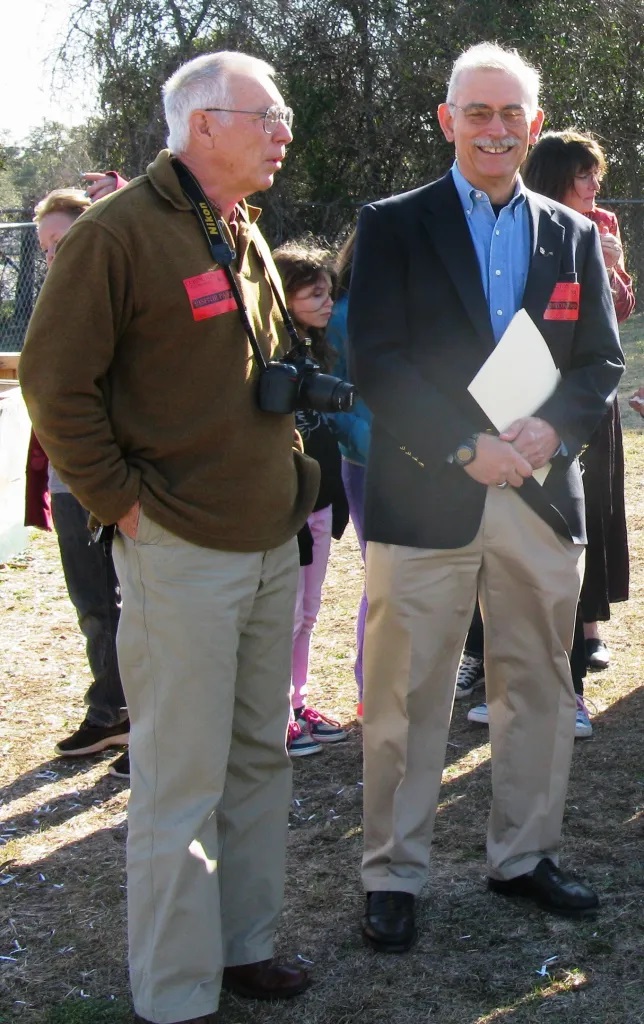Author: Bill Ward
One of my good buddies in the Boerne Chapter of the Native Plant Society of Texas is Delmar Cain. He is like several others of us who have taken an interest in native plants during our post-retirement years.
It was not that much of a stretch for me to get more interested in native plants after retirement, because as a geologist I was often in the field describing rocks and paying attention to the plants that characterized the outcrops of different strata. Some plants even helped me map the distribution of certain rock types.

Delmar’s profession, on the other hand, kept him inside a lot. He was a lawyer of high repute in the Texas A&M System. Retirement to the Boerne area gave him a chance to more fully explore his lifelong interest in the outdoors. Luckily for us, he found his way to the Boerne Chapter of NPSOT. I say we were lucky, because Delmar is a man of great curiosity, and his curiosity always is leading to good ideas for us to test. He would have been a good scientist.
One of his recent good ideas has led the Boerne Chapter to try to promote education about native plants by aiding elementary and middle-school teachers who want to use hands-on projects involving native plants as a way to draw their students into investigating the natural world.
Knowing that one of our goals in NPSOT is to educate young people about the value of native plants, Delmar came to a Boerne Chapter board meeting to say that he had been thinking about the plight of the hardworking public school teachers who commonly must use their own money for teaching aids and equipment for special projects.
Delmar thought there might be local innovative teachers who would have implemented educational projects using plants if only funds had been available to support the projects. Shouldn’t the Boerne Chapter see if there are, indeed, worthwhile projects we could encourage and assist in our community schools? This good idea of Delmar’s led the Boerne Chapter to consider the idea of “Native-Plant Watch.”

Native-Plant Watch would be a pilot educational grant program for elementary and middle school teachers in the Boerne Independent School District (BISD), sponsored by the Boerne NPSOT Chapter. The purpose of the program would be to encourage projects that help students learn about the conservation, value, and use of Texas native plants and native-plant habitats. The goals would be achieved by making some funds available directly to teachers who have projects using native plants, but do not have the financial resources to complete the projects.
The Boerne Chapter board encouraged Delmar to test his idea. So he contacted Chris Ormiston, BISD Science Coordinator, and found just what he had suspected. Ormiston told him about Lora Beth Escalante, a 4th grade teacher at Curington Elementary School. She wanted to construct a garden, filled with vegetables and native plants, which she could use in any number of ways to demonstrate fundamental science concepts to her students. She had the full encouragement of Principal Jean Perry, and the support of her students’ parents, some of whom were lining up supplies. Ms. Escalante already had started a composting project using the biodegradable leftovers from school lunches.
The Boerne NPSOT Chapter added more fuel to the project by presenting Ms. Escalante with a check, which allows her to purchase fencing, garden tools, and native plants. The check was presented on February 26th. Now all that is needed is a decision from Principal Perry on a location for the garden.
From now on, the Boerne Chapter will make the Native-Plant Watch educational grant annually. Interested elementary and middle-school teachers can apply online by going to the Boerne Chapter webpage on the NPSOT website www.www.npsot.org.
With the help of the Native-Plant Watch educational grants, some lucky Boerne school children will learn about natural science through studying native plants. They won’t have to retire before they fully appreciate the fascinating and important role native plants play in our natural environment. I wished I’d had a teacher like Ms. Escalante in elementary school.
